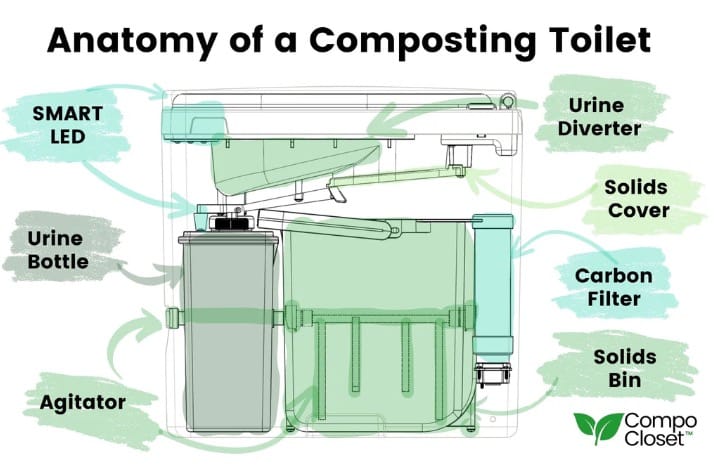How Does a Composting Toilet Work? The Basics Explained
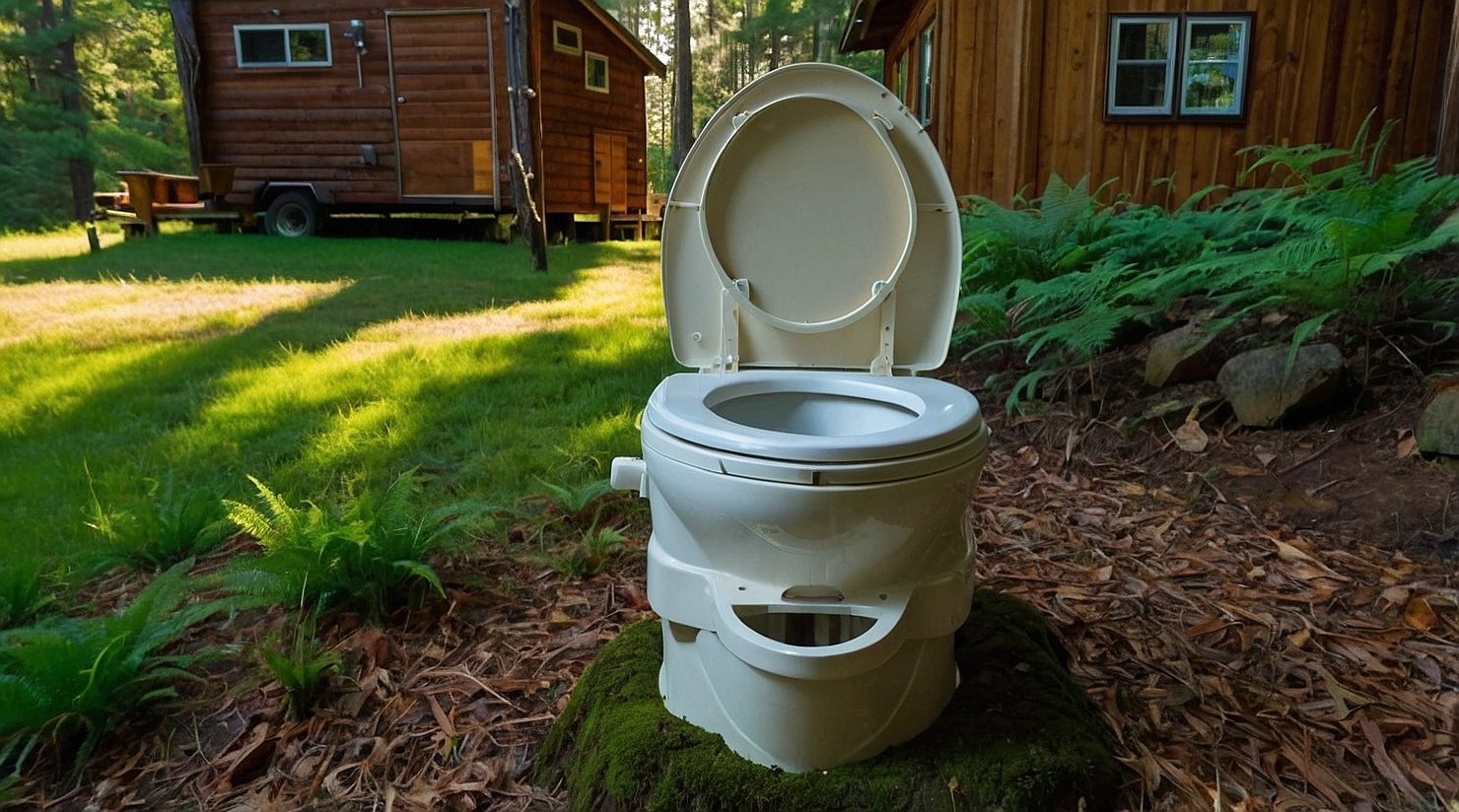
Are you considering going off-grid, exploring sustainable living, or just plain tired of porta-potty woes on camping trips? If so, you may have already asked yourself, “how does a composting toilet work?” Well, this guide has the answers.
By the time you have read this article, you will know enough about the different types of composting toilets, a clear understanding of how does a composting toilet work, the associated costs, and how often they need to be emptied. Plus, there is a whole lot more that you may not have known.
How Does a Composting Toilet Work?
Composting toilets offer an eco-friendly alternative to traditional flush toilets, diverting waste from the sewer or septic system and transforming it into usable compost. But how do these ingenious systems actually work? The process is surprisingly simple, mimicking nature’s own recycling system.
Using a Composting Toilet
Using a composting toilet is a straightforward process that feels much like using a standard toilet. Simply sit comfortably and go about your business as usual—modern composting toilets are designed with ergonomics in mind, often featuring comfortable seating and effective urine diversion to keep liquids and solids separate.
The primary difference lies in what happens next: instead of flushing, waste begins its natural decomposition process, aided by aeration, carbon materials like sawdust, and a controlled environment to break it down into safe, usable compost.
The Composting Process
How does a composting toilet work when it comes to the composting process? It all starts after use, when you add a carbon-rich material like sawdust, coconut coir, or wood chips. These materials not only help to absorb moisture and control odors but also provide the carbon needed for effective decomposition.
The composting process relies on natural microorganisms such as bacteria and fungi to break down the waste into compost. These tiny decomposers need the right balance of heat, moisture, carbon, and nitrogen to thrive. When conditions are optimal, the waste transforms into nutrient-rich compost over time, leaving behind a safe, odor-free product.
What are the Different Types of Composting Toilets?
Choosing the right composting toilet depends on factors like budget, space, and usage. To fully understand how does a composting toilet work, it’s essential to explore the different types available. Here’s a breakdown of the most common composting toilet systems:
Self-Contained Composting Toilets
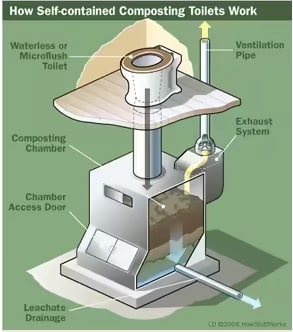
Self-contained systems house the entire composting process within a single unit. These are ideal for smaller spaces, cabins, RVs, or tiny houses where a separate composting chamber isn’t feasible. Waste is collected and composted directly within the toilet itself.
Some models use fans and ventilation systems to speed up the composting process and minimize odors. Self-contained composting toilets offer a convenient, all-in-one solution, though they typically have a smaller capacity than other systems.
Centralized Composting Toilet Systems
Centralized systems are more commonly used by a household or office and are also known as remote composting toilets. These composting systems offer a unique way to understand the original question of, “how does a composting toilet work?”
This particular system involves a central composting chamber separate from the toilet itself. Waste is transported to the composting unit via a chute or a more complex plumbing system, enabling larger capacity and suitability for homes or larger buildings with multiple users.
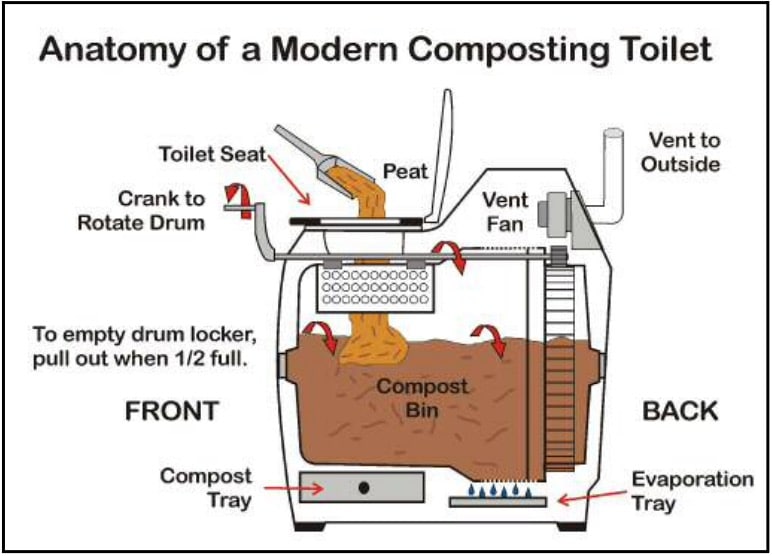
Centralized systems answer the question of how does a composting toilet work by handling more waste and offering greater flexibility in composting methods. However, depending on the system design, they require more extensive installation and may need additional components like macerators or pumps.
DIY Composting Toilets
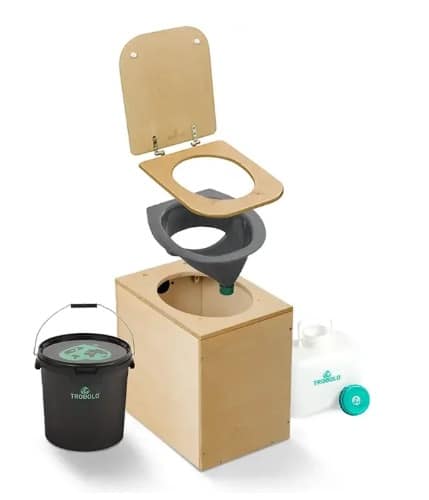
Building a composting toilet from scratch is a viable option for the budget-conscious and DIY-inclined. You can build on your own or purchase a kit from companies like Trobolo (diagram to the left). This is the most economical way, but in my opinion, the short term way.
The DIY approach involves constructing a simple container, often from a bucket or similar receptacle, and incorporating a composting medium like sawdust or coconut coir. While significantly less expensive than commercial options, DIY systems require more hands-on management and careful attention to ventilation and moisture levels to prevent odors and ensure proper composting.
Key Considerations When Choosing a Composting Toilet
- Capacity: Consider the number of users and frequency of use to determine the appropriate capacity.
- Space Requirements: Evaluate the available space for both the toilet and the composting chamber (if applicable).
- Installation: Assess the complexity of installation and whether professional help is needed.
- Maintenance: Understand the required maintenance, including emptying the compost chamber and adding composting materials.
- Ventilation: Ensure adequate ventilation to minimize odors and promote efficient composting.
- Composting Toilet Regulations: Check local regulations regarding composting toilets before installation.
By carefully considering these different types and factors, you can select the composting toilet system that best aligns with your needs and lifestyle.
Mythbusting the Composting Toilet: Odor Control
One of the biggest misconceptions about composting toilets is the dreaded smell. Many assume these eco-friendly alternatives must reek, but the truth is, a properly maintained composting toilet shouldn’t smell bad at all.
To truly understand how does a composting toilet work, it’s important to recognize the role of design and natural processes in odor control. So, where does the typical toilet odor go? The answer lies in the ingenious design and the natural processes at work.
So, where does the typical toilet odor go? The answer lies in the ingenious design and the natural processes at work.
The Science Behind Odorless Composting
Nature provides a blueprint for separating liquid and solid waste, and composting toilets mimic this for effective odor control. The key is keeping these two waste streams separate, allowing for different treatment approaches.
Urine: Liquid Gold, Not a Stench
Urine itself is relatively harmless and odorless. To fully understand how does a composting toilet work, it’s important to recognize the role of urine in the composting process. Rich in nitrogen, phosphorus, and potassium, urine is a fantastic fertilizer.
The familiar unpleasant smell often associated with urine arises when it mixes with water, particularly water containing dissolved lime, and from the buildup of uric acid scale over time. Composting toilets prevent this by diverting urine into a separate container, typically a 10-liter canister that needs emptying every 2-4 days.
Composting toilets prevent this by diverting urine into a separate container, typically a 10-liter canister that needs emptying every 2-4 days. This frequent emptying minimizes the chance for odor development.
Solid Waste: The Drying Secret
The secret to odorless solid waste management in a composting toilet is rapid drying. Two primary methods achieve this:
- Carbon-Rich Cover Material: Materials like sawdust or pet litter, rich in carbon, are used as a cover material. This cover material absorbs moisture from the solid waste and allows for evaporation, preventing odor formation. In hotter climates or with extended collection periods, occasional venting or a fan can prevent condensation buildup.
- Ventilation with a Fan: A fan can supplement or replace cover material. It actively vents moist air, accelerating the drying process and removing any nascent odors. Using a fan allows for longer collection periods between emptying.
By understanding these simple principles of separation and drying, you can effectively manage a composting toilet and keep it odor-free, enjoying the benefits of this sustainable waste management solution.
Maintenance and Troubleshooting
Maintaining a composting toilet is key to its efficient and odor-free operation. To understand how does a composting toilet work, it’s essential to recognize that it requires more hands-on care compared to a conventional flush toilet.
Think of it less as “flush and forget” and more as “cultivate and compost.” This approach highlights how does a composting toilet work to achieve water savings and environmental benefits, making the extra effort worthwhile.
Regular Compost Removal
The heart of composting toilet maintenance is regular compost removal. How often you need to empty the composting chamber depends on the toilet’s size, usage frequency, and the type of composting system. Some systems may require emptying every few weeks, while others can go for months.
Consult your composting toilet manual for specific recommendations. Once removed, the composted material can be further cured in a separate composting bin before being used as a soil amendment in your garden, offering a closed-loop system for waste management.
If you are not ready to use the compost yourself, check with your local composting facilities as some may accept it. Always follow local regulations regarding compost disposal.
Urine Diversion and Management
Many composting toilets use a urine-diverting system to separate liquid and solid waste. This helps to reduce odors significantly and speeds up the composting process. Urine is typically collected in a separate container or tank. The frequency of emptying depends on the size of the container and toilet usage.
It can often be emptied directly onto your garden (avoiding direct contact with edible plants) as a nitrogen-rich liquid fertilizer, or it can be diluted with water and used in the same manner. Some areas may have regulations around wastewater disposal , so it is always best to check with local authorities.
Cleaning and Ventilation
Regular cleaning of the toilet seat, lid, and surrounding area is essential for hygiene, just like with a regular toilet. A non-toxic, biodegradable cleaner is recommended. Proper ventilation is crucial for odor control and efficient composting.
Check the vent regularly to ensure it’s clear of obstructions and that the fan (if your model has one) is functioning correctly. Some composting toilets utilize a small heater to aid in the composting process. These should also be checked periodically to ensure they’re working as intended.
Troubleshooting and Repairs
Occasionally, you may encounter issues like unpleasant odors or slow composting. These can often be resolved by adjusting the moisture level within the composting chamber – adding composting materials such as sawdust, coconut coir, or peat moss can help absorb excess moisture. For more complex problems or repairs, consult your composting toilet’s manual or contact the manufacturer for assistance.
How Much Does a Composting Toilet Cost?
Switching to a composting toilet is a big decision, and cost is a major factor. While composting toilets offer significant long-term environmental and economic benefits, the initial investment can be higher than a conventional toilet. Understanding the various cost factors will help you budget appropriately and choose the right system for your needs.
Average Composting Toilet Prices
Expect to pay anywhere from $600 to upwards of $5,000 for a composting toilet. Several factors influence the final price, including:
- Type of Composting Toilets: Self-contained units, like those found at Home Depot , are generally the most affordable, starting around $600. More complex systems, such as split systems with remote composting chambers, can cost significantly more. Popular brands like Nature’s Head offer various models across different price points.
- Capacity and Features: Larger capacity toilets designed for higher usage will typically be more expensive. Features like electric starters, built-in ventilation fans, and urine diverting systems also add to the cost.
- Installation Complexity: Self-contained units are relatively easy to install, often requiring minimal plumbing modifications. Split systems, on the other hand, might necessitate professional installation, adding to the overall expense. Consult resources on composting toilet installation for more information.
Considering Long-Term Costs and Savings
While the initial purchase price of a composting toilet can seem daunting, it’s important to consider the long-term cost savings. These eco-friendly toilets eliminate the need for water, resulting in lower water bills.
They also reduce or eliminate the need for sewage disposal, saving on septic tank pumping or sewer connection fees. Depending on your local regulations, you might even be able to use the finished compost in your garden, further reducing the cost of fertilizers.
Additional Expenses
Beyond the initial purchase and installation, factor in additional costs like:
- Bulking Material: Composting toilets require bulking materials like sawdust, coconut coir, or peat moss to maintain the proper carbon-to-nitrogen ratio and absorb moisture. These materials need to be replenished regularly.
- Maintenance: While generally low-maintenance, composting toilets require occasional cleaning and emptying of the compost chamber. Some systems might also require replacement parts over time.
How Often Do Composting Toilets Need Emptying?
One of the most common questions about composting toilets is how often the tanks need to be emptied. Unfortunately, there’s no one-size-fits-all answer. Several factors influence the emptying frequency, making each composting toilet system unique in its needs. Let’s explore these variables to give you a better understanding of what to expect.
General Guidelines and Personal Experience
While a precise timeline is impossible, we can offer some general guidelines based on manufacturers’ data for a couple using a composting toilet full-time. In our experience, this aligns fairly well with real-world usage.
Typically, the liquids tank needs emptying every two to four days. The composting chamber, or solids tank, typically requires emptying and refreshing every month or so, which translates to roughly every 60 to 80 uses. Keep in mind that these are estimates, and your personal experience might vary.
Finding Your Rhythm
The best way to determine your composting toilet’s emptying schedule is to monitor it closely. Pay attention to the levels in both tanks. Some composting toilets even have indicators to help.
You’ll quickly develop a sense of how often your system needs attention. Ultimately, you empty the tanks when they need it, simple as that.
FAQs About How Does a Composting Toilet Work
Conclusion
Composting toilets are a bit more involved than flush toilets. However, understanding exactly how does a composting toilet work highlights its benefits for off-grid living and sustainability. From environmental impact to self-sufficiency, composting toilets offer a practical solution where conventional bathrooms are unavailable or unsuitable.
These systems save money by consuming less water, making them a cost-effective option. They are also simple to set up and use, offering flexibility for off-grid homes and tiny houses. Composting toilets also support other types of compost, which utilize natural materials from animals and plants for agricultural, construction, and other purposes.
A composting toilet includes all the main components of an indoor toilet system while providing additional environmental benefits. This guide outlines many of the advantages of composting toilets, which make them a viable alternative to traditional flush systems.

